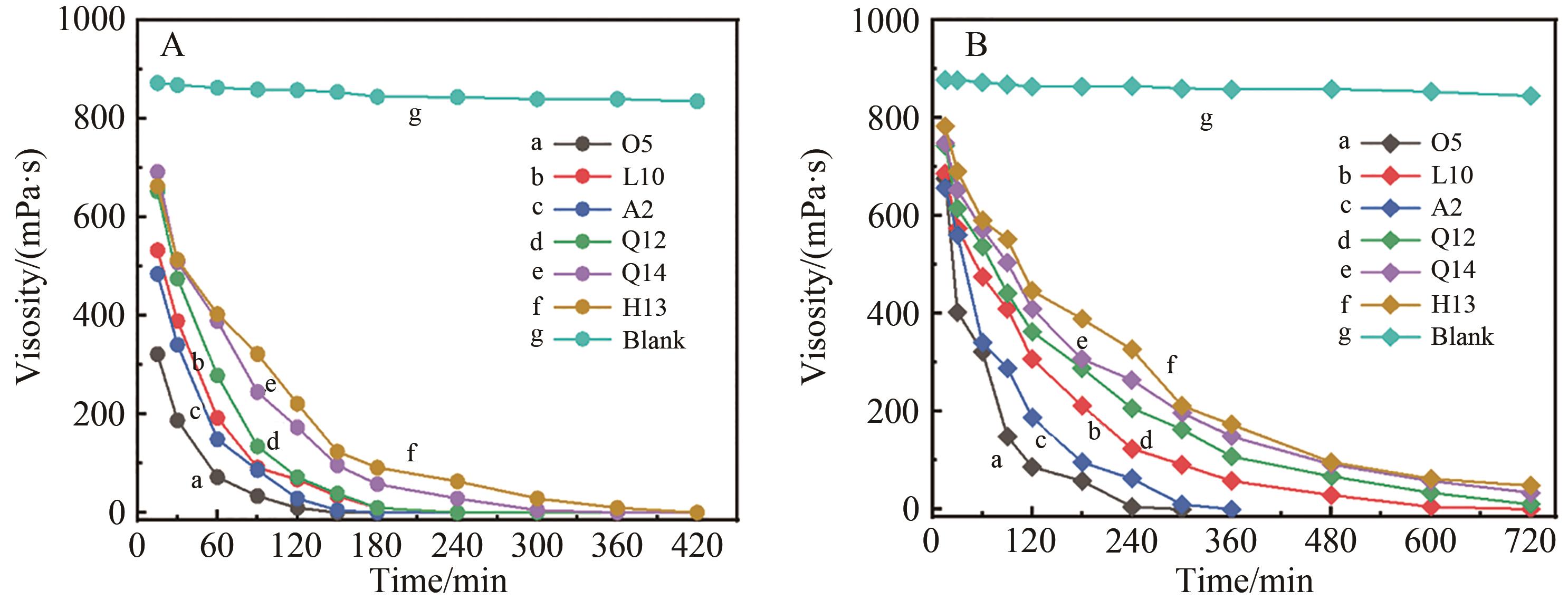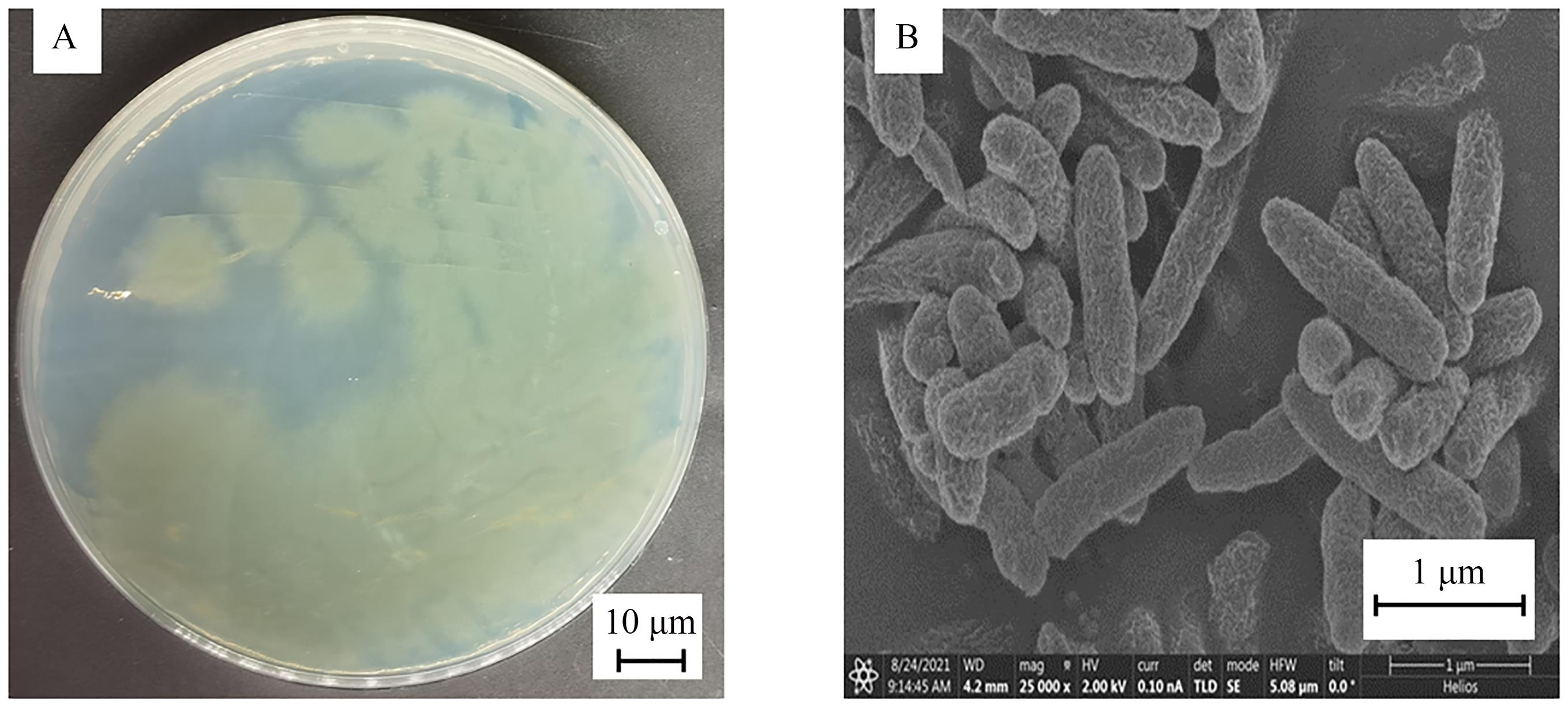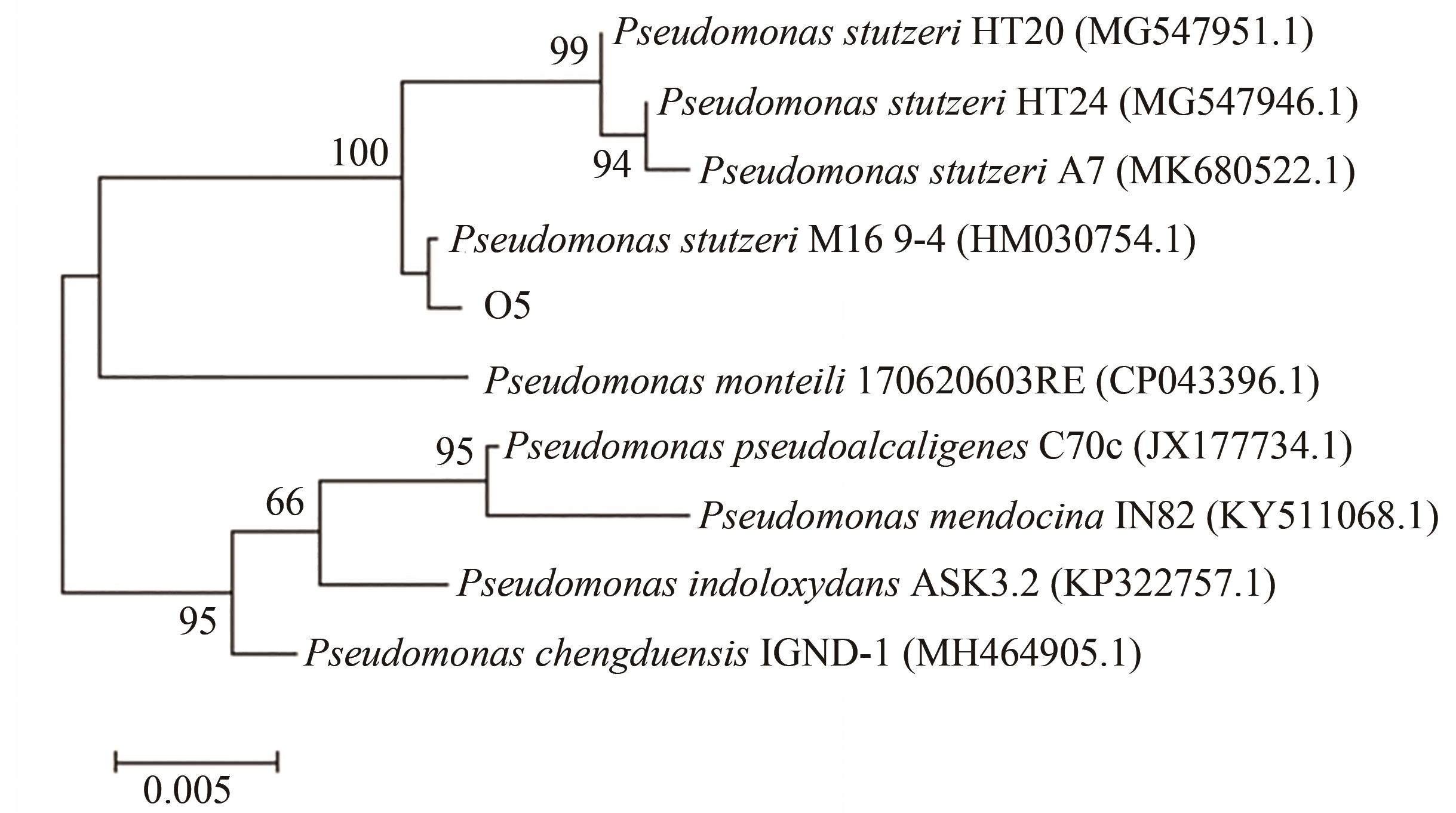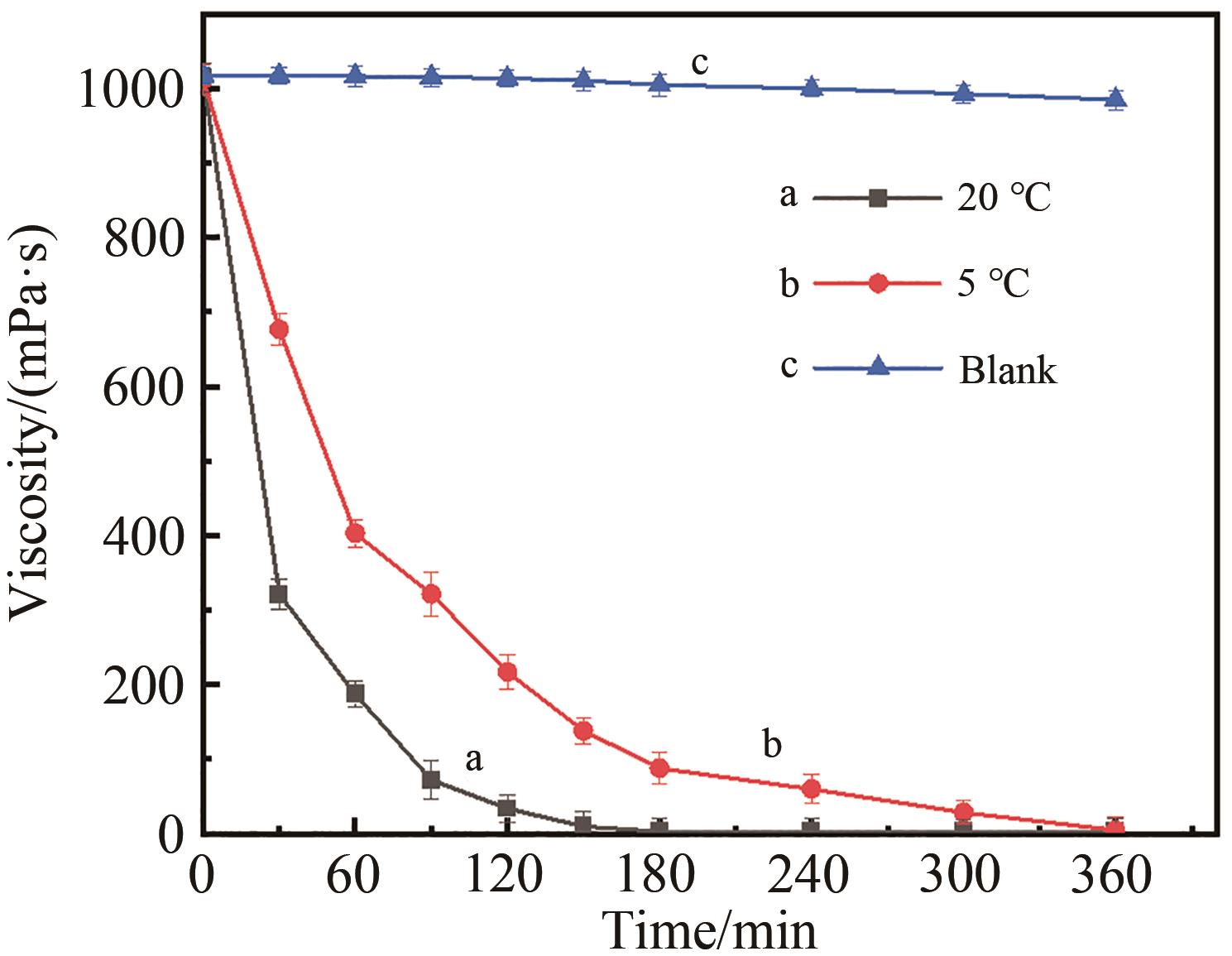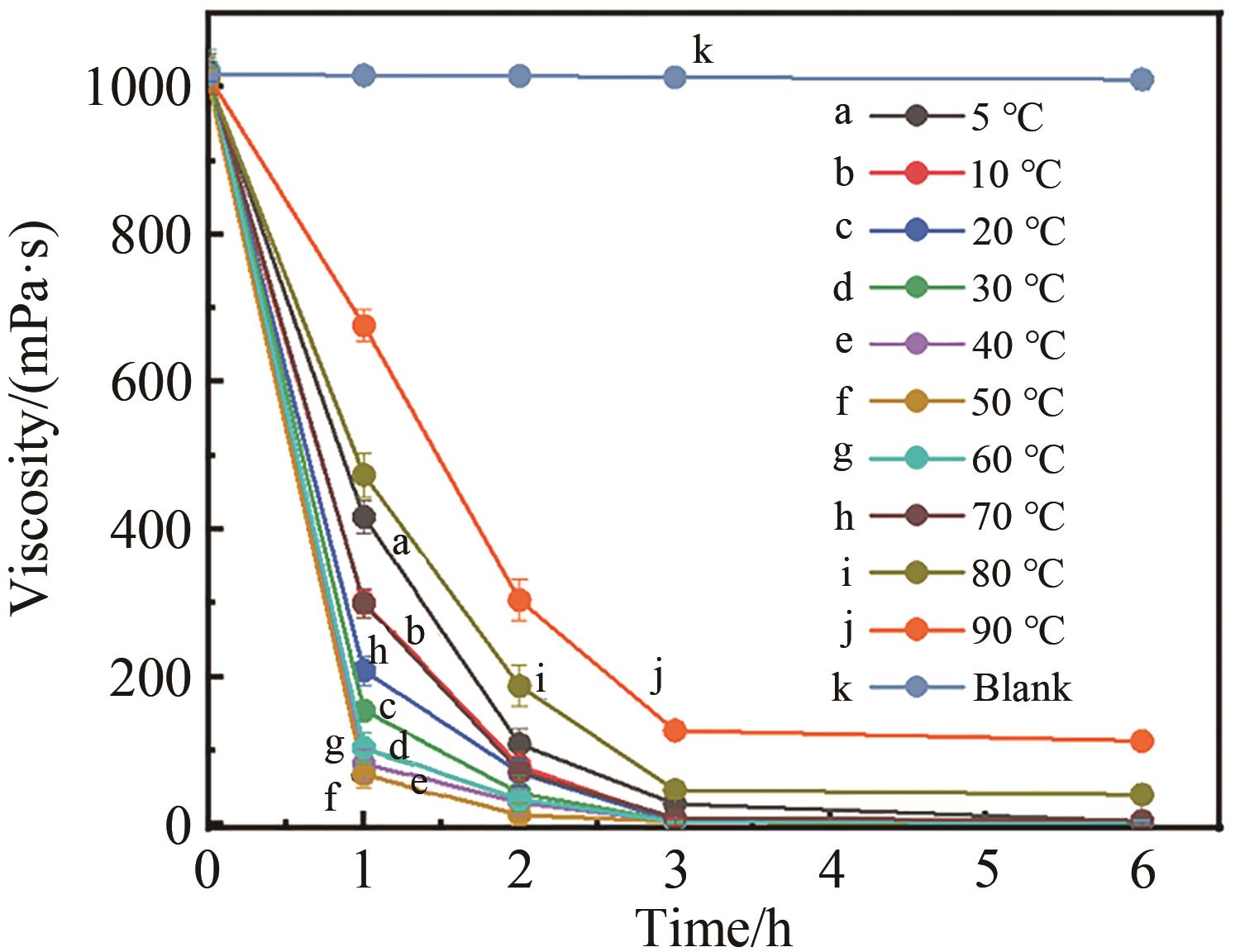
Chinese Journal of Applied Chemistry ›› 2023, Vol. 40 ›› Issue (1): 134-145.DOI: 10.19894/j.issn.1000-0518.220139
• Full Papers • Previous Articles Next Articles
Enzymatic Properties and Gel Breaking Performance of Low-temperature β-Mannanase
Yu-Hua XIONG, Lei ZHOU, Shi-Zhong YANG, Bo-Zhong MU( )
)
- East China University of Science and Technology Institute of Applied Chemistry,Biological Oil Recovery Engineering Research Center of the Ministry of Education,Shanghai 200237,China
-
Received:2022-04-17Accepted:2022-10-08Published:2023-01-01Online:2023-01-28 -
Contact:Bo-Zhong MU -
About author:bzmu@ecust.edu.cn
CLC Number:
Cite this article
Yu-Hua XIONG, Lei ZHOU, Shi-Zhong YANG, Bo-Zhong MU. Enzymatic Properties and Gel Breaking Performance of Low-temperature β-Mannanase[J]. Chinese Journal of Applied Chemistry, 2023, 40(1): 134-145.
share this article
Add to citation manager EndNote|Ris|BibTeX
URL: http://yyhx.ciac.jl.cn/EN/10.19894/j.issn.1000-0518.220139
| Strain | Enzyme activity/(U·mL-1) | Strain | Enzyme activity/(U·mL-1) | Strain | Enzyme activity/(U·mL-1) |
|---|---|---|---|---|---|
| A1 | 101.1 | H25 | 136.1 | O36 | 99.9 |
| A2 | 143.2 | J24 | 77.8 | Q1 | 111.7 |
| A5 | 90.8 | J33 | 100.2 | Q3 | 118.6 |
| A6 | 100.3 | K20 | 108.3 | Q4 | 126.7 |
| A8 | 79.1 | K33 | 117.4 | Q10 | 123.1 |
| A9 | 89.3 | L10 | 157.1 | Q12 | 92.2 |
| H1 | 96.7 | L11 | 89.6 | Q14 | 119.0 |
| H6 | 82.3 | O3 | 92.1 | S4 | 116.1 |
| H9 | 90.2 | O5 | 208.9 | S11 | 90.3 |
| H11 | 99.8 | O11 | 88.8 | X1 | 113.3 |
| H12 | 115.1 | O12 | 80.2 | X36 | 125.2 |
| H13 | 122.7 | O27 | 68.8 | X44 | 136.9 |
| H22 | 59.7 | O32 | 136.2 | X64 | 122.8 |
| H24 | 98.0 |
Table 1 β-Mannanase activity of 40 isolated strains
| Strain | Enzyme activity/(U·mL-1) | Strain | Enzyme activity/(U·mL-1) | Strain | Enzyme activity/(U·mL-1) |
|---|---|---|---|---|---|
| A1 | 101.1 | H25 | 136.1 | O36 | 99.9 |
| A2 | 143.2 | J24 | 77.8 | Q1 | 111.7 |
| A5 | 90.8 | J33 | 100.2 | Q3 | 118.6 |
| A6 | 100.3 | K20 | 108.3 | Q4 | 126.7 |
| A8 | 79.1 | K33 | 117.4 | Q10 | 123.1 |
| A9 | 89.3 | L10 | 157.1 | Q12 | 92.2 |
| H1 | 96.7 | L11 | 89.6 | Q14 | 119.0 |
| H6 | 82.3 | O3 | 92.1 | S4 | 116.1 |
| H9 | 90.2 | O5 | 208.9 | S11 | 90.3 |
| H11 | 99.8 | O11 | 88.8 | X1 | 113.3 |
| H12 | 115.1 | O12 | 80.2 | X36 | 125.2 |
| H13 | 122.7 | O27 | 68.8 | X44 | 136.9 |
| H22 | 59.7 | O32 | 136.2 | X64 | 122.8 |
| H24 | 98.0 |
| Additives | Viscosity of gel breaking solution after 3 h/(mPa·s) |
|---|---|
| KCl | 2.64 |
| Na2CO3 | 4.80 |
| NaHCO3 | 2.07 |
| Glutaraldehyde | 3.85 |
| Borax | 3.09 |
| Guar gum blank | 1.92 |
Table 2 Compatibility of the ME-O5 with different fracturing fluid additives
| Additives | Viscosity of gel breaking solution after 3 h/(mPa·s) |
|---|---|
| KCl | 2.64 |
| Na2CO3 | 4.80 |
| NaHCO3 | 2.07 |
| Glutaraldehyde | 3.85 |
| Borax | 3.09 |
| Guar gum blank | 1.92 |
| Temperature/℃ | Surface tension/(mN·m-1) | Interfacial tension/(mN·m-1) | Residue content/(mg·L-1) |
|---|---|---|---|
| 10 | 22.86 | 0.94 | 438.00 |
| 20 | 22.41 | 0.77 | 379.00 |
| 50 | 21.15 | 0.73 | 414.00 |
Table 3 Evaluation of gel-breaking fluid
| Temperature/℃ | Surface tension/(mN·m-1) | Interfacial tension/(mN·m-1) | Residue content/(mg·L-1) |
|---|---|---|---|
| 10 | 22.86 | 0.94 | 438.00 |
| 20 | 22.41 | 0.77 | 379.00 |
| 50 | 21.15 | 0.73 | 414.00 |
| 1 | TANG J, LI H, YAN S, et al. In situ synthesis, structure, and properties of a dendritic branched nano-thickening agent for high temperature fracturing fluid [J]. J Appl Polym Sci, 2020, 137(5): 48446. |
| 2 | 夏熙, 杨二龙. 页岩气压裂液研究进展及展望[J]. 化学工程师, 2019, 33(7): 59-63. |
| XIA X, YANG E L. Research progress and prospect of shale gas fracturing fluid[J]. Chem Eng, 2019, 33(7): 59-63. | |
| 3 | 黄飞飞, 蒲春生, 陆雷超, 等. 胍胶压裂液高效破胶降解剂体系研究[J]. 应用化工, 2021, 50(5): 1168-1172. |
| HUANG F F, PU C S, LU L C, et al. Complex agent system used for the effectively breaking and degrading of the guar gum fracturing fluid[J]. Appl Chem Ind, 2021, 50(5): 1168-1172. | |
| 4 | 尤佳, 刘金峰, 杨世忠, 等. MEMA10耐低温复合酶活性与破胶性能[J]. 油田化学, 2016, 33(4): 612-618. |
| YOU J, LIU J F, YANG S Z, et al. Activity and gel breaking performance of a low-temperature-tolerant complex enzyme MEMA10[J]. Oilfield Chem, 2016, 33(4): 612-618. | |
| 5 | 安毅, 田哲熙,刘灏亮, 等. 过硫化物对压裂液破胶性能的实验研究[J]. 化学工程师, 2017, 31(7): 15-18. |
| AN Y, TIAN Z X, LIU H L,et al. Experimental study on the fracture performance of the fracturing fluid by the over sulfide[J]. Chem Eng, 2017, 31(7): 15-18. | |
| 6 | OZKAN E, RAGHAVAN R. A computationally efficient, transient-pressure solution for inclined wells[J]. SPE Reserv Eval Eng, 2000, 3(5): 414-425. |
| 7 | 贺晓军, 李君, 李宁涛, 等. 过硫酸铵与生物酶压裂破胶技术对比研究[J]. 石油化工应用, 2012, 31(4): 81-83. |
| HE X J, LI J, LI N T, et al. Ammonium persulfate and enzyme technology comparative study gel breaking fracturing[J]. Petrochem Ind Appl, 2012, 31(4): 81-83. | |
| 8 | 王文军, 张士诚, 温海飞, 等. 浅层水平井超低温压裂液体系研究与应用[J]. 油田化学, 2012, 29(2): 155-158. |
| WANG W J, ZHANG S C, WEN H F, et al. Study and application of fracturing fluid for ultra-low temperature in shallow buried fracturing horizontal wells[J]. Oilfield Chem, 2012, 29(2): 155-158. | |
| 9 | 李风光. 浅层低渗透油气井超低温压裂液体系研究[J]. 油气井测试, 2021, 30(5): 37-43. |
| LI F G. Study on ultra-low temperature fracturing fluid system for shallow oil and gas wells with low permeability[J]. Well Testing, 2021, 30(5): 37-43. | |
| 10 | 韩卓, 郭威, 张太亮, 等. 非常规压裂返排液回注处理实验研究[J]. 石油与天然气化工, 2014, 43(1): 108-112. |
| HAN Z, GUO W, ZHANG T L, et al. Experimental study on reinjection treatment of unconventional fracturing flow-back fluid[J].Chem Eng Oil Gas, 2014, 43(1): 108-112. | |
| 11 | SRIVASTAVA P K, KAPOOR M. Production, properties, and applications of endo-β-mannanases[J]. Biotechnol Adv, 2017, 35(1): 1-19. |
| 12 | SONI H, GANAIE M A, PRANAW K, et al. Design-of-experiment strategy for the production of mannanase biocatalysts using plamkarnel cake and its application to degrade locust bean and guar gum[J]. Biocatal Agric Biotechnol, 2015, 4(2): 229-234. |
| 13 | MOREIRA L, FILHO E. An overview of mannan structure and mannan-degrading enzyme systems[J]. Appl Microbiol Biotechnol, 2008, 79(2): 165-178. |
| 14 | CAROL M, UTCHEN M C. Characterization of extremely thermostable enzymatic breakers (α-1,6-galactosidase and β-1,4-mannanase) from the hyperthermophilic bacterium Thermotoganeapolitana5068 for hydrolysis of guar gum[J]. Biotechnol Bioeng, 1996, 52(2): 332-339. |
| 15 | KLYOSOV A A, DOTSENKO G S, HINZ S W A, et al. Structural features of β-(1→4)-D-galactomannans of plant origin as a probe for β-(1→4)-mannanase polymeric substrate specificity[J]. Carbohydr Res, 2012, 352: 65-69. |
| 16 | SRIVASTAVA P K, KAPOOR M. Production, properties, and applications of endo-β-mannanases[J]. Biotechnol Adv, 2016, 35(1): 1-19. |
| 17 | 张蕊, 朱虹, 周峻沛, 等. β-甘露聚糖酶分子生物学研究进展[J]. 中国农业科技导报, 2018, 20(5): 34-46. |
| ZHANG R, ZHU H, ZHOU J P, et al. Research progress on molecular biology of β-mannanases[J]. J Agric Sci Technol, 2018, 20(5): 34-46. | |
| 18 | BEHERA S, DEV M J, SINGHAL R S. Cross-linked beta-mannanase aggregates: preparation, characterization, and application for producing partially hydrolyzed guar gum[J]. Appl Biochem Biotechnol, 2022, 194(5): 1981-2004. |
| 19 | COMFORT D A, CHHABRA S R, CONNERS S B, et al. Strategic biocatalysis with hyperthermophilic enzymes[J]. Green Chem, 2004, 6(9): 459-465. |
| 20 | MAHAMMAD S, COMFORT D A, KELLY R M, et al. Rheological properties of guar galactomannan solutions during hydrolysis with galactomannanase and alpha-galactosidase enzyme mixtures[J]. Biomacromolecules, 2007, 8(3): 949. |
| 21 | 丁铮, 王静, 潘永强, 等. 生物酶对高黏度压裂返排液破胶处理研究[J]. 现代化工, 2015, 35(12): 71-74. |
| DING Z, WANG J, PAN Y Q, et al. Research of enzyme for gel breaking of high viscosity fracturing flow-back fluid[J]. Mod Chem Ind, 2015, 35(12): 71-74. | |
| 22 | BLIBECH M, FARHAT-KHEMAKHEM A, KRIAA M, et al. Optimization of beta-mannanase production by Bacillus subtilis US191 using economical agricultural substrates[J]. Biotechnol Prog, 2020, 36(4): 1-9. |
| 23 | CHAUHAN P S, PURI N, SHARMA P, et al. Mannanases: microbial sources, production, properties and potential biotechnological applications[J]. Appl Microbiol Biotechnol, 2012, 93(5): 1817-1830. |
| 24 | DAWOOD A, MA K. Applications of microbial β-mannanases [J]. Front in Bioeng Biotechnol, 2020, 8(598630): 1-17. |
| 25 | 郑允志, 王冰, 王兴刚. β-甘露聚糖酶对夏季高温蛋鸡生产性能、蛋品质和养分表观消化率的影响[J]. 中国饲料, 2018(16): 42-45. |
| ZHENG Y Z, WANG B, WANG X G. Dietary supplementation of β-mannanase on laying performance, egg qualityand apparent digestibility of nutrients in laying hens under hot climatic condition[J]. China Feed, 2018(16): 42-45. | |
| 26 | 谈苏慧, 卢海强, 陈伟, 等. 1株产甘露聚糖酶嗜热真菌的鉴定、酶学性质表征及转录组学分析[J]. 食品科学, 2021, 42(18): 65-72. |
| TAN S H, LU H Q, CHEN W, et al. Identification, enzymatic characterization and transcriptomic analysis of a mannanase-producing thermophilic fungus[J]. Food Sci, 2021, 42(18): 65-72. | |
| 27 | 施鑫磊, 方韵颖, 尉俏女, 等. 一种来源于喜热梭孢壳的耐热型β-甘露聚糖酶[J]. 微生物学报, 2021, 61(9): 2815-2828. |
| SHI X L, FANG Y Y, WEI Q N, et al. Characterization of a hyperthermostable β-mannanase from Thermothelomyces thermophilus[J].Acta Microbiol Sin, 2021, 61(9): 2815-2828. | |
| 28 | 谢家仪, 董光军, 刘振英. 扫描电镜的微生物样品制备方法[J]. 电子显微学报, 2005, 24(4): 440. |
| XIE J Y, DONG G J, LIU Z Y. Method of preparation of microbiological specimen for scanning electron microsope[J]. J Chin Electron Microsc Soc, 2005, 24(4): 440. | |
| 29 | MILLER G L. Use of dinitrosalicylic acid reagent for determination of reducing sugar[J]. Anal Biochem, 1959, 31(3): 426-428. |
| 30 | KATROLIA P, ZHOU P, ZHANG P, et al. High level expression of a novel β-mannanase from Chaetomium sp. exhibiting efficient mannan hydrolysis[J]. Carbohydr Polym, 2012, 87(1): 480-490. |
| 31 | BRADFORD M M. A rapid and sensitive method for the quantitation of microgram quantities of protein utilizing the principle of protein-dye binding[J]. Anal Biochem, 1976, 72(1): 248-254. |
| 32 | DOWNIE B, HILHORST H, BEWLEY J D. A new assay for quantifying endo-beta-D-mannanase activity using congo red dye[J]. Phytochemistry, 1994, 36(4): 829-835. |
| 33 | ZHOU J, ZHANG R, GAO Y, et al. Novel low-temperature-active, salt-tolerant and proteases-resistant endo-1,4-β-mannanase from a new Sphingomonas strain[J]. J Biosci Bioeng, 2012, 113(5): 568-574. |
| 34 | HUANG J L, BAO L X, ZOU H Y, et al. High-level production of a cold-active β-mannanase from Bacillus subtilis BS5 and its molecular cloning and expression[J]. Mol Genet Microbiol Virol, 2012, 27(4): 14-17. |
| 35 | PONGSAPIPATANA N, DAMRONGTEERAPAP P, CHANTORN S, et al. Molecular cloning of kman coding for mannanase from Klebsiella oxytoca KUB-CW2-3 and its hybrid mannanase characters[J]. Enzyme Microb Technol, 2016, 89: 39-51. |
| 36 | YOU J, LIU J F, YANG S Z,et al. Low-temperature-active and salt-tolerant beta-mannanase from a newly isolated Enterobacter sp. strain N18[J]. J. Biosci Bioeng, 2016, 121(2): 140-146. |
| 37 | LI C Y, LIU F F, YE J, et al. A low-temperature active endo-β-1,4-mannanase from Bacillus subtilis TD7 and its gene expression in Escherichia coli[J]. Appl Environ Biostechnol, 2018, 3(2): 17-25. |
| 38 | 陈英, 王亚南, 陈绍宁, 等. 用于压裂液的生物酶破胶剂性能评价[J]. 钻井液与完井液, 2010, 27(6): 68-71. |
| CHEN Y, WANG Y N, CHEN S N, et al. Evaluation of bio-enzyme breaker used in fracturing fluid[J]. Drill Fluid Completion Fluid, 2010, 27(6): 68-71. | |
| 39 | 高敏, 江建林. 水基压裂液体系的制备及性能[J]. 石油化工, 2020, 49(12): 1188-1193. |
| GAO M, JIANG J L. Preparation and properties of a water-based fracturing fluid system[J]. Petrochem Technol, 2020, 49(12): 1188-1193. | |
| 40 | BATTISTEL E, BIANCHI D, FORNAROLI M, et al. Enzymes breakers for viscosity enhancing polymers[J]. J Pet Sci Eng, 2011, 77(1): 10-17. |
| 41 | 李军, 王潜, 齐海鹰, 等. 新型生物酶破胶剂的研究与应用[J]. 石油矿场机械, 2008, 37(10): 90-92. |
| LI J, WANG Q, QI H Y, et al. Development and application of new biological enzyme gel breaker[J]. Oil Field Equip, 2008, 37(10): 90-92. |
| Viewed | ||||||
|
Full text |
|
|||||
|
Abstract |
|
|||||
